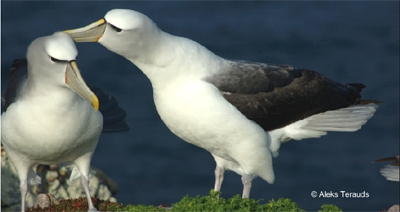The Action Plan for Australian Birds 2010 by Stephen Garnett, Judit Szabo and Guy Dutson is the third in a series of Australian action plans for birds that have been produced at the start of each decade. The new book, published in September 2011, analyses the threatened status of species and subspecies of Australia's birds, including those of the offshore territories, and covers non-breeding visitors. For each taxon the size and trend in its population and distribution have been analysed using the latest version of the World Conservation Union (IUCN) Red List criteria to determine risk of extinction.
Each account covers the 2010 status and also provides a retrospective assessment of the status in 1990 and 2000 based on current knowledge, taxonomic revisions and changes to Red List criteria, and then discusses why the status of some taxa has changed over the last two decades.
A total of 21 of the 29 current ACAP-listed albatrosses and petrels is covered in the book, all Southern Hemisphere-breeding species. Nineteen of these species with a globally threatened or Near Threatened status are given full accounts, whereas the two "Least Concern" giant petrels Macronectes spp. receive brief accounts in an Appendix that lists taxa previously included in the 2000 action plan.
Because subspecies are considered, there are three "conservation summary" accounts for Buller's Albatross Thalassarche bulleri: for the species, and separately for the southern form T. b. bulleri and for the northern T. b. platei. However, the Antipodean Albatross Diomedea antipodensis is covered only by the Auckland Island population of D. a. gibsoni. Also covered are five species of shearwaters Puffinus spp., several of which have been considered as "potential candidate species" for listing within the Agreement.
The individual conservation summaries are from one to two and a half pages long and include the heads Conservation Status, Reasons for Listing, Status 2000, Status 1990, Taxonomy, Range, Abundance, Ecology, Threats, Conservation Objectives, Information Required, Management Actions Required, and Bibliography.
Maps are given of the taxon's distribution within Australia, including within its Exclusive Economic Zone and the sub-Antarctic island groups of Heard & McDonald and Macquarie. The six threatened ACAP-listed species that breed within Australia have their breeding sites marked on the maps by red arrows. With the exception of the Shy Albatross Thalassarche cauta that breeds on three islands around Tasmania, all are restricted in their breeding within Australia to the one or both of the two sub-Antarctic islands mentioned above.

Shy Albatrosses. Photograph by Aleks Terauds
The taxon summaries also include tables assessing eligibility for listing against the Red List Criteria. Conservation status is assigned separately for Australian breeding and visiting populations. For example, the Grey-Headed Albatross T. chrysostoma is categorized as Critically Endangered for its Australian population (with just a hundred-odd pairs breeding on Macquarie) as opposed to Vulnerable for the visiting population. The globally Near Threatened Grey Petrel Procellaria cinerea is accorded a status of Endangered for the still small Macquarie Island breeding population, now recovering from predation by feral cats Felis catus and perhaps Black Rats Rattus rattus and the destruction of vegetation by European Rabbits Oryctolagus cuniculus, following eradication efforts (click here).
The book is nicely printed and seems reasonably sturdy as a paperback for desk-consultation over the next decade. An ebook version is also available for USD 55.00.
Click here for news of a related publication which evaluates trends in the status of Australian birds over the period 1990 to 2010.
References:
Garnett, S.T., Szabo, J.K. & Dutson, G. 2011. The Action Plan for Australian Birds 2010. Collingwood: CSIRO Publishing. 456 pp. ISBN 9780643103689. Paperback. AUD 49.95.
Szabo, J.K., Butchart, S.H.M., Possingham, H.P. & Garnett, S.T. 2012. Adapting global biodiversity indicators to the national scale: A Red List Index for Australian birds. Biological Conservation http://dx.doi.org/10.1016/j.biocon.2012.01.062.
With thanks to Melinda Chandler, CSIRO Publishing.
John Cooper, ACAP Information Officer, 9 March 2011

 Français
Français  English
English  Español
Español